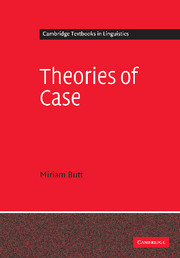2 - Foundational Perspectives
Published online by Cambridge University Press: 05 June 2012
Summary
Before he died, Daddy taught me to read ancient syntax.
[Mel (aka Xena), The Xena Scrolls, Xena: Warrior Princess]Introduction
Much of the terminology and some of the preconceptions governing modern syntactic thought find their roots in ancient times. Latin, Ancient Greek and Sanskrit are still taught as school subjects and many of us were put through declension tables which featured various forms of the noun for nominative, dative or accusative case. In my case (which is fairly typical), learning the declension tables took the form of rote memorization, but there were several questions I could have stopped to ask. For example, I could have paused to wonder what the word ‘case’ really meant, or why the declension tables are set up so that nominative always comes first, then genitive, etc. In fact, I did wonder about these questions, but only after I became a linguist.
It turns out that case is related to the Latin verb cadere ‘to fall’:
The term case is from Latin cāsus, which is in turn a translation of the Greek ptōsis ‘fall’. The term originally referred to verbs as well as nouns and the idea seems to have been of falling away from an assumed standard form …
[Blake 2001:18]The modern term case is thus directly attributable to ancient Greece via the Romans. This is also true for the standard case names employed in syntactic analyses today.
- Type
- Chapter
- Information
- Theories of Case , pp. 12 - 22Publisher: Cambridge University PressPrint publication year: 2006



